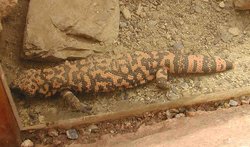Gila Monsters
|
|
| Gila Monster | ||||||||||||||
|---|---|---|---|---|---|---|---|---|---|---|---|---|---|---|
 | ||||||||||||||
| Scientific classification | ||||||||||||||
| ||||||||||||||
| Binomial name | ||||||||||||||
| Heloderma suspectum Cope, 1869 |
The Gila monster (Heloderma suspectum) is one of the two known species of venomous lizards. (The other is the Mexican beaded lizard.) The Gila (pronounced heela) monster lives in the deserts of the southwestern USA and northwestern Mexico. It is a heavy, slow moving lizard, up to 60 cm (2 feet) long. Its skin has the appearance of beads in the colours black, pink, orange, and yellow, laid down in intricate patterns across the animal's body.
Unlike a snake, the Gila monster envenomates its victim not by means of hollow teeth, but through grooves in the teeth of its lower jaw. It produces only small quantities of the neurotoxic venom, which is secreted into the lizard's saliva. By chewing its prey, however, it tries to put as much of the poison into the bloodstream of its victim as possible.
The Gila monster's bite is normally not fatal to humans (there are no reliable reports of fatalities), but it can bite quickly and is known to hold on strongly.
The name "Gila monster" refers to the Gila River Basin in Arizona.
In 2005 the Food and Drug Administration of the United States approved a drug for the management of Type 2 diabetes, Byetta (exenatide), a synthetic version of a protein derived from the Gila monster's saliva.
Subspecies
There exist two subspecies.
